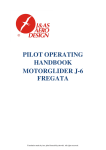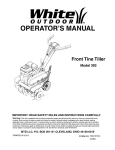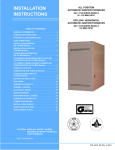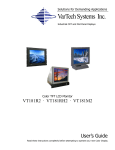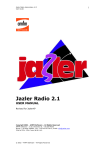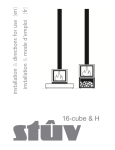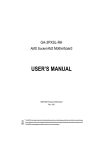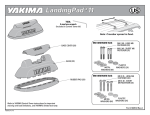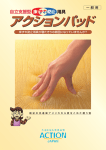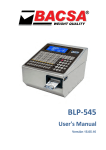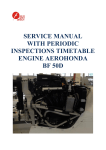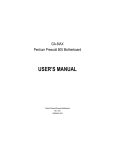Download SERVICE MANUAL MOTORGLIDER J-6 FREGATA
Transcript
SERVICE MANUAL
MOTORGLIDER
J-6 FREGATA
J&AS Aero Design Sp. z
o.o.
SERVICE MANUAL MOTORGLIDER
J-6 FREGATA
CLASS OF AIRCRAFT “SPECIAL”
THIS MOTORGLIDER CAN BE USED IN THE "SPECIAL" CATEGORY,
ONLY FOR RECREATIONAL, SPORTS, NON-PROFIT PURPOSES AND
OTHER NOT CORELATED WITH AIR TRANSPORTATION (THINGS OR
PERSONS). NOBODY HAS RIGHTS TO USE THIS MOTORGLIDER FOR
ISSUING A LICENSE OR THE ENTRY TO THE PILOT LICENSE.
(NOT APPLICABLE TO FLIGHTS PERFORMED TO ACQUIRE SKILLS
FOR THIS MOTORGLIDER).
THIS SERVICE MANUAL MUST ALWAYS BE AVAILABLE DURING ANY KIND
OF MIANTENANCE, INSPECTIONS OR PERIODIC WORKS.
* Manual was based on standards and procedures contained in CS 22
No entries or supplements can be made in this manual without approval of adequate
civil aviation authority.
In case of loss this manual, immidiately inform adequate civil aviation authority, if
outside the country – equivalent facility.
Any person who find this manual is requested to send it to the adequate civil avaition
authority.
CONTENTS
Section
GENERAL
1
DESCRIPTION
2
STANDARD MAINTENANCE
3
PARTS SERVICED BY THEIR OWN
SERVICE DOCUMENTS
4
PERIODIC INSPECTIONS
5
ALLOWABLE OPERATING LIFETIME
6
MASS AND BALANCE
7
REPAIRS
8
2
J&AS Aero Design Sp. z
o.o.
SERVICE MANUAL MOTORGLIDER
PART 1
GENERAL INFORMATION
1.1
INTRODUCTION
1.2
BASE OF APPROVAL
1.3
CAUTIONS, WARNINGS, REMARKS
1.4 DESCRIPTIVE DATA
1.5 DRAWING IN THREE PROJECTIONS
1.6
ABBREVATIONS
1.1 INTRODUCTION
This Service Manual has been prepared to provide pilots and mechanics with neccesary
information needed for safe and efficient use of J-6 Fregata motorglider.
This manual includes the material required by the Certification Specifications for
gliders and motorgliders CS-22 with exceptions, as well as additional information
provided by the manufacturer.
1.2 BASE OF APPROVAL
J-6 Fregata motorglider has been approved by the Civil Aviation Authority in
accordance with the SPECIAL categories: TEMPORARY AIRCRAFT TESTING
RULES built in single copies.
1.3 CAUTIONS, WARNINGS, REMARKS
CAUTION:
INDICATES THAT THE FAILURE OF FOLLOWING APPLICABLE
PROCEDURE WILL ENDANGER OR DETERIORATE FLIGHT SAFETY.
WARNING:
INDICATES THAT THE FAILURE OF FOLLOWING PROCEDURE LEADS TO
MINOR OR LONG-TERM MORE OR LESS FLIGHT SAFETY DETERIORATION.
REMARK:
Draws attention to detail not related directly to the safety of the flight, but important
or unusual.
3
J&AS Aero Design Sp. z
o.o.
1.4
SERVICE MANUAL MOTORGLIDER
DESCRIPTIVE DATA
DESCRIPTION
J-6 FREGATA is a single seat motorglider, made of glass-epoxy composites and designed
for touristic flights and maintaining skills. Cantilever construction with V-tail. Fixed
landing gear with tail wheel. The power unit is a pushing one. Bicipital aerofoil.
Rectangular-trapezoidal shape of the wings. Each wing has aerodynamic brake that is
extended from upper surface. Internal fuel tanks are mounted inside every wing. One-piece
canopy that is opened aside and fitted with emergency droping system. Fixed rudder
mounting, adjustable pilot seat and vetilation of the cabin. Control stick is on right side of
the cabin. Control system for ailerons, elevator and aerodynamic brakes – by pushrods.
Engine AEROHONDA BF 50D with brake power of 37.5 kW at 6000 rpm. Two blades,
fixed propeller made of wood. Rotation is to the left-viewing from behind.
BASIC DATA:
Wing span ................................................................................... 12,55 m
Lenght ......................................................................................... 5,11 m
High ............................................................................................ 1,58 m
Lift area ...................................................................................... 9,13 m2
Aspect ratio ................................................................................ 17,25
Wing loading .............................................................................. 43,8 kG/m2
Main aerodynamic chord ............................................................ 0,762 m
Distance between reference chord and hull’s chord….…………0,038 m
Dihedral angle..…………………………………………………1.5o
Wing swept angle....…………………………………………….0o
Surface of empennage..…………………………………………1.48 m2
Empennage span......…………………………………………….2.96 m
Angle between wings’ half.............…………………………….105o
Weights data
Basic empty mass
292,4 kG
Maximum payload
147,6 kG
Minimum wing mass
102,5 kG
Maximum mass in flight
440,0 Kg
4
J&AS Aero Design Sp. z
o.o.
1.5
SERVICE MANUAL MOTORGLIDER
DRAWING IN THREE PROJECTIONS:
Motorglider J-6 FREGATA Fig. 1.1
1.6
ABBREVATIONS
A - ampere
Ah - ampere-hour
C - degree Celsius
cm - centimeter
daN - dekaniuton
h - hour
kg - kilogram
kG - kilogram-force
km - kilometer
m - meter
mm - milimeter
MPa - megapascal
V - volt
HC – hull’s chord
RC – reference chord
5
J&AS Aero Design Sp. z
o.o.
SERVICE MANUAL MOTORGLIDER
PART 2
DESCRIPTION
2.1
INTRODUCTION
2.2
CONSTRUCTION
2.2.1 WINGS
2.2.2 EMPENNAGE
2.2.3 FUSELAGE
2.2.4 LANDING GEAR
2.3
CONTROL SYSTEMS
2.4
EQUIPMENT AND INSTALLATIONS
2.4.1 POWER UNIT
2.4.2 PRESSURE INSTALLATION OF INSTRUMENTS
2.4.3 INSTRUMENTS
2.4.4 ELECTRICAL AND RADIO SYSTEM
2.4.5 ELECTRICAL BONDING SYSTEM
2.4.6 VENTILATION SYSTEM
2.4.7 CABIN EQUIPMENT
2.4.8 FUEL SYSTEM
2.4.9 OIL SYSTEM
2.5
PLACARDS AND MARKINGS
2.6
MOUNTING DATA
2.6.1 CLEARANCE LIMITS IN UNITS CONNECTIONS
2.6.2 CLEARANCE LIMITS IN CONTROL SYSTEMS
2.6.3 FORCE LIMITS FOR STARTING CONTROL SYSTEMS
2.1
INTRODUCTION
Part 2 contains description of motorglider, its systems, equipment, the list of plates and
markings along with their location and installation data necessary for the proper functioning
of motorglider.
2.2
CONSTRUCTION
2.2.1 WINGS
Wings have rectangular shape with trapezoidal tip, cantilevered. Wing dihedral is equaled
1.5. Aerofoil of Wortman Fx 67K170, fixed and rectangular with chord equaled 0.8 m. One
spar construction with two-circuits caisson and distance piece covered. Sine-wave web spar.
Integral fuel tanks are built in wings.
AILERON
Non-gaps aileron with mass balance is mounted on three hinges. Construction is made of
composite, distance piece covered. Drive lever is placed in the center of aileron.
6
J&AS Aero Design Sp. z
o.o.
SERVICE MANUAL MOTORGLIDER
AERODYNAMIC BRAKES
Motor glider is fitted with aerodynamic brakes, extended form upper surface of the wings.
Lever is placed inside the cockpit on the left side.
2.2.2 EMPENNAGE
Rudlicki’s tail empennage, made and secured in a special slot in the beam of the hull.
Divided into stabilizer and rudder. Stabilizer with a single spar. Coatings of stabilizer and
rudder made in distance piece covered.
2.2.3 FUSELAGE
Composite fuselage. Laminated skin, stiffened by formers. Single-piece canopy, opened to
the right.
2.2.4 LANDING GEAR
MAIN LANDING GEAR
Fixed main landing gear – two wheels mounted on two springs, made of glass-epoxy
composite. Drum brake, controlled mechanicaly (cable). Dimensions are 350 x 135,
pneumatic pressure 0.2+0.02MPa (2+0.2 atm.) (access to the delivery valve is possible from
the cabin after removing wheel cover).
TAIL LANDING GEAR
Tail gear is amortized and controlled by the cables connected to the rudder. Angles of
deflections +/- 20 degrees. The rear wheel has dimensions of 15 x 30 (6 x 1 ¼ "), max
pressure to 0.63 Mpa, optimal 0.5+0.2 Mpa.
2.3
CONTROL SYSTEMS
Motorglider is fitted with conventional control systems. Ailerons and aerodynamic brakes –
by pushrods. Rudder control system driven by pushrods and strings.
In the hull behind the wings is a device which change rudder and the control stick
movements to the corresponding butterfly tail rudder deflection. Main wheel brake driven by
strings in Bowden armor. Pedals are not adjustable. The trimmer consists of an electric
motor system stretching springs attached to the elevator pushrod.
CAUTION:
ADJUSTMENTS OF CONTROL SYSTEMS FOR ELEVATOR, AILERONS, RUDDER
AND AERODYNAMIC BRAKES SHALL BE TREATED AS REPAIRING PROCES
AND ALL THE CONDITIONS MUST BE MET AS MENTIONED IN SECTION 8 OF
THIS MANUAL.
7
J&AS Aero Design Sp. z
o.o.
SERVICE MANUAL MOTORGLIDER
1) Adjustment of control systems is carried out in the event of excessive deviation in the
operation of the systems. Normaly pushrod’s systems do not need adjustment.
2) Control openings in pushrods should be covered by the ends of the regulated threads.
3) Pushrods regulated tips should be secured by lock nuts.
4) Adjustable pushrods tips should be set so that, at each position of the control stick in the
cabin (eg. all the way forward and to the right), clearance was perceptible when
rotating pushrod relative to its longitudinal axis. It does not apply to the pushrods at
cranes with un-drag bearings.
5) Screw fenders on the stick should be secured by lock nuts.
6) Turnbuckles tip threads in rudder control system should be unvisible. Turnbuckles
should be secured by lock wire.
2.4
EQUIPMENT AND INSTALLATIONS
2.4.1 POWER UNIT
Engine AEROHONDA BF 50D is equipped with electronic fuel injection system, ignition
advance angle adjustment, stabilization and automatic mixture adjustment. On-board
diagnostic system monitors engine management system, indicating by lamp OBD faults, and
by diagnostic fault codes to specify the sign, or a glass of OBD diagnostic tool with Honda.
The engine is equipped mechanical and electrical fuel pump, alternator built into the flywheel, starter, driven coolant pump V-belt and belt drive reduces the speed of the propeller.
Throttle control is done using the lever on the left side.
Maintenance should be performed according to oryginal copy of Service Manual for Fregata
J6 and for engine AEROHONDA BF 50D (doc. no AH/IBF50D/I/2012)
Fixed pitch, two blades propeller with diameter of 1.25 m.
Torque moment for nuts mounting propeller is equaled 1,5 kGm.
2.4.2 PRESSURE SYSTEM FOR INSTRUMENTS
The flight instruments pressure system consists of the following elements combined in the
typhical way:
- airspeed indicator (see p. 2.4.3),
- vertical speed indicator (see p. 2.4.3),
- altimeter (see p. 2.4.3),
- vertical speed indicator total energy compensator KWEC-2 (see section 4),
- expansion vessel TM-420 C,
- steam drier,
- tee and four-pole,
- connector,
- static pressure source,
- total pressure source,
Lines connector allows to entirely disconnect instruments from motorglider. It has endings
that are marked in following colours:
-
D – red
- to total pressure,
S - yellow
- to static pressure,
T - black - to expansion vessel (thermos),
8
J&AS Aero Design Sp. z
o.o.
SERVICE MANUAL MOTORGLIDER
2.4.3 INSTRUMENTS
Motorglider is equipped with a set of flight instruments needed to fly in the full range of use
specified in pilot operating handbook.
INSTRUMENTS
-
airspeed indicator
altimeter
vertical speed indicator
compass
turn coordinator
7 FMS 513
4 FGH 40
5 StVM 10-2
WW 5266
QM II
ENGINE INSTRUMENTS
-
Honda RPM gauge
electrical cooling liquid temp. indicator
electrical oil temp. indicator
electrical fuel level. indicator
oil pressure light
fuel reserve light
2.4.4 ELECTRICAL SYSTEM AND RADIO SYSTEM
Wiring diagram is shown in Figure 2-10.
The electrical system consists of the following power sources:
-
Lead-acid battery with a capacity of 12Ah and 12V (6),
-
Alternator (1) with built-in voltage regulator (built on the engine (2)).
Receivers with installations are:
-
Feeder and coolant temperature indicator (19),
-
Feeder and oil temperature gauge (17),
-
Feeder and oil pressure indicator (20),
-
Emitter and fuel gauge (18),
-
Feeder tank and the outgoing light fuel reserve (21),
-
Ignition driver (8),
-
Tachometer (9),
-
Turn coordinator (22),
-
Engine start circuit: starter (5), conatctor (4), breaker (7),
-
Actuator of the trimming system (16) with switch (15),
-
Radio communication (14), radio on switch (13),
-
Circuit breakers: (3), (10), (12),
-
Auxiliary power socket (11).
Used sources creating energy that far exceeds demands.
9
J&AS Aero Design Sp. z
o.o.
SERVICE MANUAL MOTORGLIDER
Ignition circuit is independent of the electrical system.
Radio system consists of following elements:
-
radio communicaton
-
rod antenna,
-
button on the control stick ( transmision - reception)
-
connecting sockets for headphones and microphone
Wiring system diagram
Fig. 2-10
2.4.5 ELECTRICAL BONDING
-
installation connecting control systems and engine to the rear discharge unit at tail
wheel
2.4.6 VENTILATION SYSTEM
-
air intake at the bottom front of the hull giving air to the bottom of the housing of the
instrument panelchwyt
veiled hole plate rod combined with a scoop, which allows you to control the flow of air
2.4.7 EQUIPMENT OF THE CABIN
Descrition of the cabin equipment is specified in pilot operating handbook.
10
J&AS Aero Design Sp. z
o.o.
SERVICE MANUAL MOTORGLIDER
Additionally in the cabin are:
front landing gear bracket – holder for a key needed to open tanks caps in the
wings,
right side of container – holders for wing pins after their disassembly,
left side – holders for empennage bolts after its disassembly
2.4.8
FUEL SYSTEM
Fuel system is shown in the below diagram:
1) fuel inlet,
2) fuel tanks - integral, located in front part of each wing, ahead of the spar. Fuel capacity of
each tank is 30 dm3 (total - 60 dcm3)., equiped with fuel meters - - electric, capacitive,
cooperating with dual fuel indicator in the cockpit. Expansion tank with capacity of 2.5 dm3
is fitted with reserve fuel sygnaling Unusable fuel is around 1.0 dm3
4) shutt-off fuel valve
5) fuel filter with drain
6) bend (firewall),
7) flexible line,
8) fuel pump (on engine),
8
7
1
1
1
2
2
TO THE
FUEL
PUMP
3
I
L
4
7
Fuel system.
7
S
Y
S
T
E
M
5
6
O
i
l
11
J&AS Aero Design Sp. z
o.o.
SERVICE MANUAL MOTORGLIDER
2.4.9 OIL SYSTEM
Oil system consists of following elements:oil reservoir located in fuselage,
oil cooler,
oil pump in the engine,
- lines starting with the reservoir, which task is to provide oil to the circuit before the oil is
sucked from the tank.
12
J&AS Aero Design Sp. z
o.o.
SERVICE MANUAL MOTORGLIDER
2.5 PLACARDS AND MARKINGSPlacards and markings in the cabin:
1
2
3
4
5
6
7
8
9
10
11
12
13
14
– emergency canopy drop (right side, red colour – pull to drop),
– canopy lock (left side, white colour),
– trimming device (nose down),
– trimming device (nose up),
– aerodynamic brakes closed,
- aerodynamic brakes opened,
– wheel brakes,
- ventialtion,
– seat adjustment,
– maximum baggage allowance placard
– maximum weights placard,
– maximum values of speed and approved aerobatic maneuvers placard
– approved type of flights placard
– approved category placard
(outside, on the left side)
7
8
13
3 4
5
9
16
10
1
2
11
12
Placards in the cabin
Fig. 2-11
13
J&AS Aero Design Sp. z
o.o.
SERVICE MANUAL MOTORGLIDER
1. Canopy drop
(right side)
2. Canopy lock
(left side)
3. Trimming device
(nose down)
4. Trimming device
(nose up)
5. Aerodynamic brakes closed
6. Aerodynamic brakes opened
7. Wheel brakes
8. Ventilation
9. Seat adjustment
BAGGAGE
MAX. 10 kG
10. Maximum baggage allowance placard
MOTORGLIDER J-6 FREGATA
Max. weight in flight 440 kG
Allowable weights in cabin
Min. 60 kG Max. 110, kG
11. Take-off performance placard
MOTORGLIDER J-6 FREGATA
Never exceeded VNE = 237 km/h
Maneuvering VA = 194 km/h
Approved aerobatic maneuvers: rapid nose up and
down , deep turns, static stall
14
J&AS Aero Design Sp. z
o.o.
SERVICE MANUAL MOTORGLIDER
12. Maximum values of speed and approved aerobatic maneuvers placard
THIS AIRCRAFT RECEIVED PERMISSION TO CONDUCT FLIGHTS IN SPECIAL CATEGORY
AND IT DOES NOT MEET THE REQUIREMENTS RELATING TO WIDE
AND SPECIFIC PROVISIONS OF AIRWORTHINESS WHICH ARE BASED ON THE ANNEX 8 TO
THE CONVENTION OF INTERNATIONAL CIVIL AVIATION
13. Approved type of flights placard
SPECJALNY - SPECIAL
14. Approved category placard
2.6
TECHNICAL DATA:
2.6.1. ALLOWED CLEARANCES IN JOINTS OF THE FOLLOWING COMPONENTS:
Clearances can be determined by repeated measuring pin and bushing diameter in various directions
using micrometer and subtracting from the largest diameter of bushing the smallest measured
diameter of the pin. If clearances do not exceed the values listed below, you can use the motor
glider until the next required inspection (see section 5 of this manual)
Joint
Coadjutant parts
Allowed clearances
wing-fuselage
main bolts-gap in
ball joint
0.1 mm
wing-wing
bolt – otwór tulei
w bagnecie
0.1 mm
V-tail-fuselage
Lower surface of the tail – socket in
fuselage beam
Any perceptible
clearanes are not
allowed
2.6.2. ALLOWED CELARANCES IN CONTROL SURFACES:
Control
surface
Clearance measuring
Allowed clearance
Elevator
at the aft of the rod – when blocked
1 mm
Ailerons
at the aft of the rod – first one aileron
blocked than second
1 mm
Allowed clearance between bolts and bushings in mountings cannot exceed 0.1 mm.
15
J&AS Aero Design Sp. z
o.o.
SERVICE MANUAL MOTORGLIDER
2.6.3. ALLOWED FORCES TO RUN CONTROL SURFACES
Control surface
Force measurement
Allowable value
Elevator
Ailerons
Rudder
in the middle of the hold stick
in the middle of the hold stick
on the rudder bar
in the middle of the hold – when
unlocked
max. 0.2 daN
max. 0.2 daN
max. 0.5 daN
min. 2 daN
max. 4 daN
min. 0.5 daN
max. 1 daN
Aerodynamic brakes
Emergency drop of the
canopy
on the hold
PART 3
STANDARD MAINTENANCE
3.1
INTRODUCTION
3.2
STANDARD MAINTENANCE
3.2.1
3.2.2
3.2.3
3.2.4
3.2.5
3.2.6
PRE-FLIGHT CHECK
POST-FLIGHT CHECK
PARKING, SECURING AND ROLLING
IN THE HANGAR AND ROAD TRANSPORT
CLEANING
ASSEMBLY AND DISASSEMBLY PROCESS
3.3
LUBRICATING
3.4
ADJUSTEMNTS
3.5
ASSEMBLY AND DISASSEMBLY PROCESSES
3.5.1
3.5.2
3.5.3
3.5.4
3.1
AILERON
AERODYNAMIC BRAKE
V-TAIL
CANOPY
INTRODUCTION
Part 3 contains a list and description of the steps carried out in the normal operating
conditions, with the exception of systems listed in sections 4 and 9, and periodic inspections
listed in Part 5.
3.2
STANDARD MAINTENANCE
3.2.1 PRE-FLIGHT CHECK
Pre-flight check :
1) Check all the documents of motor glider.
16
J&AS Aero Design Sp. z
o.o.
SERVICE MANUAL MOTORGLIDER
2) Cockpit.
- Chceck condition of the glass, open canopy
- Chceck if pins of the wing are properly mounted and secured by safety pinss,
- Set starter for first position and chceck engine gauges, fuel quantity and trimming
włożyć kluczyk do stacyjki i przekręcić o jedną pozycję
- Remove key from the starter
- Check control surfaces for condition and free of movements
- Chceck aerodynamic brakes for condition and free of movement
- Chceck the cabin if there are no unwiling objects-remove
- Chceck canopy for proper securing
- Chceck seat belts
- Chceck static and dynamic air sources
3) Landing gear.
- Chceck condition and pressure in tyres
- Chceck brake and shock absorbing
- Chceck wheels for free of rotation
- Chceck mounting of tail wheel and its control
4) Right wing.
- Chceck surface, leading and trailing edge
- Chceck if there are no unwiling clearances between wing and fuselage
- Chceck ailerons, deflections, friction, driving unit connects
- Chceck aerodynamic brakes for condition
- Chceck control unit of ailerons and brakes inside the cabin
5) Power unit.
- Chceck oil quantity
- Chceck quantity of cooling liquid
- Chceck silencer for proper mounting and cracks
- Chceck mounting of oil, cooling and fuel hoses
- Chceck if there is no oil, fuel or cooling liquid leakage
- Chceck propeller to crankshaft mounting and condition
- Chceck systems to engine mounting
- Check condition and tension of gear toothed belt,
- Check condition and tension of V-belt that drives cooling liquid,
- Chceck propeller surface and its cap
- Chceck visualy fuel quantity in tanks
6) Control surfaces.
- Check mounting, securing, surface condition, defelctions and frictions
7) Fuselage.
- Check skin of the airframe if there are no cracks on painting,
- Check inlet hole of oil cooler
- Check drain valves for permeability
8) Left wing – as same as right wing.
3.2.2
POST-FLIGHT CHECK
-
Cool down engine below 90 °C and then shut it down
-
Check if there are no oil, fuel and cooling liquid leakage
-
Clean canopy glass and if necessary drain water from static and dynamic lines
17
J&AS Aero Design Sp. z
o.o.
SERVICE MANUAL MOTORGLIDER
3.2.3 PARKING, SECURING AND ROLLING
PARKING
During stop canopy should be closed and protected by cover.
CAUTION:
Never leave unsecured motorglider without supervision.
SECURING ON THE GROUND
-
place the motor glider as wind blows from the tail and left or right one side,
secure using wing tips, main landing gear and tail wheel strut spring,
secure control stick
ROLLING MOTOR GLIDER
Motor glider can be rolled by hand in accordance with generally accepted principles. During
the long rolling canopy should be closed, and control stick should be secured.
CAUTION:
Never push on the wing tips, empennage and control surfaces.
3.2.4 IN THE HANGAR AND ROAD TRANSPORT
IN THE HANGAR
Motor glider should be stored in a dry and ventilated place. If longer storage takes place it is
necessary to protect fittings from corrosion by grease.
When storing disassembled motor glider, its systems should be placed in such a way that
cannot created permanent deformation:
- wings - leading edge down side, supported on the leading edge, near to closing rib or
supported by the bayonets, and at the end of the wings on a soft, fitted stand,
- airframe - the matching cover, and the back of the hull can plant a stand;
- empennage – on the soft ground to the bottom of the leading edge
CAUTION:
After outside storage the inside of the structure should be chcecked if there is no water
then cleaned and dried.
ROAD TRANSPORT
In order to prepare motor glider for transport following points should be done:
- chceck completeness of motor glider,
- empty the cabin,
- close windown and canopy,
- cover the canopy,
- secure tips of control unit sticking out from wings against unwanted movements,
- secure ailerons and control surfaces,
- fix motor glider on the trailer such way to prevent formation damage
18
J&AS Aero Design Sp. z
o.o.
SERVICE MANUAL MOTORGLIDER
CAUTION:
1. Permeability of fuel tanks venting must be provided.
2. Motor glider transported using open trolley should be protetected by covers.
3.2.5 CLEANING
Motor glider should be washed with water and normal detergent using a sponge or soft cloth.
Similar media should be used to clean the propeller. After cleaning, check the permeability
of the drainage holes
and, if necessary - dry interior of the structure (especially the brake boxes).
The engine should be washed by any items intended for automotive engine or by kerosene.
Glazing should be wiped with a soft cloth and the dull should be polished by polishing
paste. The cockpit should be cleaned regularly with a vacuum cleaner.
.
WARNING:
Using organic solvents as petrol, nitro etc. to clean canopy is forbidden.
3.2.6 ASSEMBLY AND DISASSEMBLY PROCESS
ASSEBLY
A) Team: 3 persons (or 4 persons without special aids)
B) Assembly aids : support for airframe
C) Instruction of assembly step by step :
1. clean and lubricate all the fittings, pins and joints of control systems.
2. place airframe on the suport aids, remove canopy
3. assemble right wing first: put tip of the spark into hull (do not forget about fuel line, fuel
venting and electrical wire) and in the final stage
enter fittings on pins protruding from the airframe
4. then left wing: put tip of the spark into hull (do not forget about fuel line, fuel venting
and electrical wire) and in the final stage
enter fittings on pins protruding from the airframe
5. set together spars’ tips and enter main pins in fittings hole, at the end secure them using
safety pin
CAUTION:
PINS CAN BE ENTERED MANUALLY, WITHOUT USING ANY TOOLS. IN CASE
OF FRICTION, ASSEMBLY SHOULD BE STOPPED AND CHECK IF THE PINS
HAVE BEEN CLEANED CORRECTLY.
6. Connect and protect the aileron control systems and aerodynamic brakes in the hull,
7. Connect the fuel lines, fuel venting and electrical fuel gauges,
8. V-tail wing set up the appropriate slot in the back of the hull, and insert the bottom of
the hull two threaded bolts,
9. From the top to set up the bolts and washers and tighten the nuts and secure cotter or
pin,
19
J&AS Aero Design Sp. z
o.o.
SERVICE MANUAL MOTORGLIDER
10. Screw the brackets to the right axis hinge tail control surfaces and then secure the
wire,
11. Put the tip on the levers rudder pushrods, put on and tighten the nut and then protect
them with safety pins,
12. After checking the correctness of the assembly to set up and secure with screws
casing,
13. If the base used for mounting the hull - remove the motor-glider with bases,
14. Put on canopy and set up supply lines to connect to the system pressure flight
instruments - check for leaks,
DISASSEMBLY PROCESS:
Disassembly takes place in the reverse order.
Bayonets’ pins of wings and screws of horizontal tail should be placed in appropriate
holders, located on the main wheel cover inside the hull.
3.3
LUBRICATING:
For lubricating you need to use ŁT-43 grease or other lubricant for bearings. Surfaces moving
relative to each other, their joints and tilting ball bearings are supposed to be lubricated.
Lubricating points:
1. Tilting and joint bearings in control system in ailerons, elevator and aerodynamic
brakes.
2. Guideline of aerodynamic brakes’ pushrod and its mounting.
3. Axis of rotation of the tail gear fork.
4. Mounting panel of the aerodynamic brakes.
3.4
ADJUSTMENTS
All the adjustments processes performed on engine and fuselage must be consulted with
motorglider builders.
In case of making stabilization or any kind of leveling, consult it with motorglider builders.
20
J&AS Aero Design Sp. z
o.o.
3.5
SERVICE MANUAL MOTORGLIDER
ASSEMBLY AND DISASSEMBLY PROCESSES OF PARTICULAR UNITS
CAUTION:
BEFORE INSTALLING UNITS, CO-ACTING METAL SURFACES SHOULD BE
CLEANED AND LUBRICATED (NOT APPLICABLE TO SLEEVES BEARING
MADE OF PLASTIC). NEVER USE SELF-LOCKING NUTS, COTTER PINS AND
LOCK WASHERS AGAIN.
3.5.1 AILERON
Aileron disassembly process should be made as follows:
- Disconnect the aileron control system by unscrewing the nut and remove the bolt
connecting pushrod tip with aileron lever (at central suspension).
- Deflect aileron up to maximum position.
- Remove cotter pins and pull the pins from the hinges.
- Pull aileron to the back
Aileron assembly process is performed in reverse order.
3.5.2 AERODYNAMIC BRAKE
Aerodynamic brake disassembly process should be made as follows:
- Open aerodynamic brakes.
- Unscrew self-locking nuts from bolts.
- Pull out bolts fixing panels.
Disassembly process of straps should be made as follows:
- Unscrew nuts and remove springs tightening strap.
- Remove strap, being careful not to bend it.
Aerodynamic brake assembly process is performed in reverse order, remembering about
adjusting travel force of blocking system, if straps had been disassembled.
3.5.3 V-TAIL RUDDER
V-tail rudder disassembly process should be made as follows:
-
Remove lock (wire) from two bolts fixing lever.
Unscrew both bolts.
Remove V-tail by axial movement (direction outside)
V-tail rudder assembly process is performed in reverse order, remembering about locking
bolts.
3.5.4 CANOPY
Canopy disassembly process should be made by two men as follows:
-
Open canopy and detach protection (tape).
Close the canopy to ensure that person standing on the left side has access to the
emergency drop lever.
21
J&AS Aero Design Sp. z
o.o.
-
SERVICE MANUAL MOTORGLIDER
Provide assurance for person standing to the left side of cabin to protect against damage
canopy.
Pull emergency drop lever.
With assistance remove canopy form the hull.
-
Canopy assembly process is performed in reverse order.
PART 4
PARTS SERVICED BY THEIR OWN SERVICE DOCUMENTS
4.1
INTRODUCTION
4.2
LIST OF APPROVED
DOCUMENTS
4.1
INTRODUCTION
PARTS WHICH ARE SUPPORTED BY THEIR OWN
Part 4 contains a list of approved parts regardless of the motor glider, which are
supported by their own documents. These documents should be attached to this
manual.
4.2
LIST OF APPROVED
DOCUMENTS
PARTS WHICH ARE SUPPORTED BY THEIR OWN
Lp.
Part
Type
1
Airspeed indicator
7 FMS 513
2
Altimeter
4 FGH 40
3
4
5
6
7
8
9
Vertical
speed indicator
Turn coordinator
Compass
VSI Compensator
Seat belts
Main gear
Radio
5 StVM 10-2
QM II
WW 5266
KWEC-2
J6-00-00
350 x 135
ATR 833
Proper document of service
Authorised Release Certificate
Form 1
Authorised Release Certificate
Form 1
Authorised Release Certificate
Form 1
Authorised Release Certificate
Form 1
Authorised Release Certificate
Form 1
Authorised Release Certificate
Form 1
User Manual
Metric
User and Service Manual
22
J&AS Aero Design Sp. z
o.o.
SERVICE MANUAL MOTORGLIDER
PART 5
PERIODIC INSPECTIONS
5.1
INTRODUCTION
5.2
LIST OF PERIODIC INSPECTIONS
5.3
TIMETABLE OF PERIODIC INSPECTIONS
5.1
INTRODUCTION
Part 5 contains a list and frequency of work
and maintenance to be performed periodically to ensure the safe and efficient use of
motorglider. Steps must be performed periodically and validated only by qualified
personnel.
Any technical problems occurred should be consulted
and resolved in consultation with motorglider builders.
Time between inspections of approved parts which are serviced by their own documents
must be uphold, regardless of motorglider itself.
5.2
LIST OF PERIODIC INSPECTIONS
1. Inspection of the whole hull with particular reference to the elements that are loaded
during flight and landind.
2. Inspection of the main systems and drives for security of the joints (especially main bolts
of the fuselage).
3. Inspection of the condition and agles of deflection for control surfaces and aerodynamic
brakes and its operation (without quantitation)
4. Inspection of the joints regularity for control systems in wings nad fuselage, security of
nuts, bolts, turnbuckles and pushrod tips.
5. Inspection of the friction force in drives, extending and retracting force in aerodynamic
brakes. (without quantitation).
6. Inspection of the canopy for its closing and emergency drop.
7. Inspection of the pneumatic instruments for their condition.
8. Inspection of the electric system.
9. Inspection of the fuel system for its condition and sealing.
10. Inspection of the oil system for its condition and sealing.
11. Inspection of the cooling system for its condition and sealing
12. Inspection of main gear condition, pressure in pneumatics, rolling and effictivity of
brakes.
13. Inspection of the tail gear (shock-absorber, mounting and lines).
23
J&AS Aero Design Sp. z
o.o.
SERVICE MANUAL MOTORGLIDER
14. Inspection of the protective covers on metal elements of drives and ferrules for their
condition.
15. Inspection of cover painting for its condition.
16. Cleaning and lubricating of bearings by the new grease.
17. Inspection of engine lords for their condition.
18. Inspection of the engine mount for its condition.
19. Inspection of the control systems by throttle and starter.
20. Inspection of the propeller for its condition, mounting and adjsuting.
21. Inspection of the electrical bonding.
22. Perform lubricating as described in p. III.
23. Inspection of main parts after disassembly the motor glider.
24. Inspection of the surface for coandjutant parts (main bolts and ferrules).
25. Inspection of mounting clearances in joints as follows:wing to fuselage,fuselage to Vtail).
26. Oil change.
27. Cooling liquid change.
28. Inspection of the torque for nuts that connects propeller to the hub.
5.3
TIMETABLE OF PERIODIC INSPECTIONS:
You must follow the table given below:
Interval
Type of inspection
according to p.IV
When not flown for more than 6 months
1 to 25
Every 50FH or 12 months
28
Every 100FH or 12 months
1 to 22
Every 200FH
1 to 27
24
J&AS Aero Design Sp. z
o.o.
SERVICE MANUAL MOTORGLIDER
PART 6
ALLOWABLE OPERATING LIFETIME
6.1
INTRODUCTION
6.2
ALLOWABLE OPERATING LIFETIME OF MOTORGLIDEr
6.3
LIST OF COMPONENTS THAT MUST BE REPLACED DURING OPERATION
6.1
INTRODUCTION
Part 6 contains allowable operating lifetime limits of motorglider and its parts that must be
replaced, other than those specified in part 4 and 9.
6.2
ALLOWABLE OPERATING LIFETIME OF MOTORGLIDE
Lifetime for the structure is based on technical condition except for components listed in
point VII.
6.3
LIST OF COMPONENTS THAT MUST BE REPLACED DURING OPERATION
Regardless of the technical condition the parts listed below must be replaced:
Lp.
Components
Time to replace
1
Rudder rod link
1000FH or 12 years
2
Gear brakes rod link
1000FH or 12 years
3
Engine lords
1000FH or 10 years
25
J&AS Aero Design Sp. z
o.o.
SERVICE MANUAL MOTORGLIDER
PART 7
MASS AND BALANCE
7.1
INTRODUCTION
7.2
WEIGHING AND BALANCING OF EMPTY MOTORGLIDER
7.3
BASIC EMPTY MASS
7.4
BALANCING OF CONTROL SURFACES
7.1
INTRODUCTION
Part 7 contains the acceptable range of weight and center of gravity of the empty
motorglider, the method of weighing and controling the center of gravity of the motorglider
and determining the state of empty motorglider completion.
In addition, part 7 gives the acceptable range of positions the control surfaces center of
gravity along the way of control.
7.2
WEIGHING AND BALANCING OF EMPTY MOTORGLIDER:
BASIC EMPTY MASS
Basic Empty Mass ......................................................................................... 270 kG
Maximum mass of fuselage with V-tail ......................................................... 184 kG
METHOD OF WEIGHING AND CONTROLING C.G. OF EMPTY MOTORGLIDER
1) Motorglider must be complete according to Fig.7.3.
2) Preapre mass and balance sheet according to Fig.7-1.
3) Set, leveled and tare 3 weights with an accuracy not worse than 0.2 kg. Under "Tare1"
and "Tare2" type in indicates taken from main wheels in the unladen condition. Under
"Tare3" type indication weight under the rear wheel in the unladen condition.
Under "Tare3" type in indication taken from tail wheel in the unladen condition.
4) Place motorglider on weights as in Fig. 7-1, (on main wheels and on tail wheel
substituting an adjustable holder at tail wheel).
5) Level the motorglider by adjusting holder below tail wheel so that the leveling point on
the leading edge at the wing rib was at the same level as the upper edge of the trailing
edge of the wing section. To control it, use of transparent tube filled with water without
air bubbles. Measure the distance of a and b, than enter them into the mass and balance
sheet.
6) Determine the weights indications and typ into "Gross (1 +2)" section the sum of the
weights of the two indications taken form the main wheels and to "Gross3" section type
in indication weight taken form the tail wheel.
7) Weigh stand at the tail wheel and add its weight to "Tare3” section. If under the main
wheels stands were used, their combined weight must be added to "Tare (1 +2)" section.
8) According to given formulas, calculate weights and C.G. position. Type all the scores
into correct sections (points 1 and 2).
9) Weight motorglider units and type all weights into mass and balance sheet (point 4).
10) Tot up all the weights of motorglider units and type in final sum.
26
J&AS Aero Design Sp. z
o.o.
SERVICE MANUAL MOTORGLIDER
WARNING:
Weights values of motorglider from the point 1) and 4) may differ due to inaccurate
measurements and the weight.
11) Weight and balance sheet must be attached to the documentation of motorglider.
12) Weighing results should be entered to PILOT OPERATING HANDBOOK.
7.3
BASIC EMPTY MASS:
Empty motor lider with necessary equipment is fitted with systems that are mentioned in this
manual. If motor glider is used with additional equipment it has to be take into consideration
during weighting process. Remember that cockpit and baggage area should be cleared of
things that are not belong to the standard equipment.
Allowable range of Center of Gravity: from 51 cm to 55 cm from the reference point.
27
J&AS Aero Design Sp. z
o.o.
SERVICE MANUAL MOTORGLIDER
WEIGHT AND BALANCE SHEET
J-6 FREGATA Serial no.:
Measured distances a = ……….. cm,
Pillar P1 i P2
Units
kG
Accuracy
. . . . . . [. . .]
Tare (1+2)
...+...=...
Gross (1+2)
......
Net (1+2)=
......
Gross(1+2)Tare (1+2)
1) Motorglider weight:
Registration marks:
b = ……….. cm
Pillar P3
Units
Accuracy
Tare 3
Gross 3
Net 3=
Gross 3 - Tare 3
kG
. . . . . . [. . .]
...+...=...
......
......
Q = Net (1+2) + Net 3 = . . . . . [kG]
2) Empty motorglider C.G. position:
XHC = {Net3(a+b) + Net(1+2)a} / {Net(1+2) + Net3} = . . . . [cm]
3) Position limits of C.G.:
XHC from 45 [cm] to 51 [cm]
4) Parts weight:
left wing
right wing
empennage
whole fuselage
. . . . [kG]
. . . . [kG]
. . . . [kG]
. . . . [kG]
______________________________________________________
Motorglider weight
= . . . . [kG]
5) Allowable basic empty weight:
Maximum weight of fuselage with empennage:
max. 292,4 [kG]
189,9 [kG]
Performed by: . . . . . . .
Data: . . . . . . . . .
Signature: . . . . . . . . .
__________________________________________________________________________
Weight and balance sheet example
Fig. 7-1
28
J&AS Aero Design Sp. z
o.o.
7.4
SERVICE MANUAL MOTORGLIDER
CONTROL SURFACES BALANCE
C.G. for ailerons must be within limits given in Fig. 7-3.
Control for aileron C.G. position (according to Fig.7-3):
1) Weight the aileron, determine indication of GL.
2) Support aileron onto the hinge pins, so that it can be rotated,
3) Aileron trailing edge put on weight with accuracy of ± 0,02 kG, determine indication of
LL (perpendicular to axis of rotation) and read out indication of PL.
4) C.G. position, behind aileron axis of rotation as follows:
XL = PL LL/GL
WARNING:
Weights indications: PL i GL must be in the same units.
LL
XL
Aileron axis
of rotation
PL
GL
For both ailerons size of xL must be ≤ 27 mm.
Aileron balance
Fig. 7-3
29
J&AS Aero Design Sp. z
o.o.
SERVICE MANUAL MOTORGLIDER
Control of V-tail C.G. position (according to z Fig.7-4):
1) Weight the rudder, determine indications of GS.
2) Support the rudder on lower fitting and upper hinge.
3) Put chosen point of mass balance on weight with accuracy of ± 0,02 kG, determine
indication of LS (perpendicular to axis of rotation) and read out indication of PS.
4) C.G. position, in front of axis of rotation as follows:
XS = PS LS/GS
WARNING:
Weights indications: PS i GS must be in the same units.
LL
LS
XS
PS
mass
balance
GS
axis of rotation
For V-tail control surfaces XS must be within limits from 0 mm to 6 mm (C.G. must be
placed in front of axis of rotation or on axis of rotation).
Control surfaces balance
Fig. 7.4
30
J&AS Aero Design Sp. z
o.o.
SERVICE MANUAL MOTORGLIDER
PART 8
REPAIRS
8.1
INTRODUCTION
8.2
GENERAL TERMS OF MAKING REPAIRS
8.1
INTRODUCTION
Part 8 contains a way in case of repairs necessity.
8.2
GENERAL TERMS OF MAKING REPAIRS:
In case of any damage that leads to perform repair, you are obligate to contact with the
manufacturer.
CAUTION:
BEFORE ANY REPAIR THE OWNER MUST CONTACT WITH THE
MANUFACTURER OR THE AUTHORITHY
TO MAKE SURE THAT
AIRWOTHINESS OF THE MOTOR GLIDER WILL NOT CHANGE.
31































